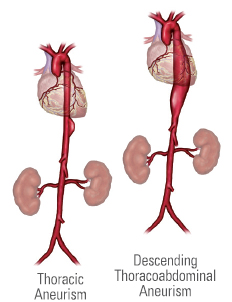Director:
Vascular and Endovascular Sciences
Vice President:
Vascular Access Society of India
Editorial Board:
Annals of Vascular Surgery
Councilor:
Asian Society of Vascular Surgery

A thoracic aortic aneurysm is a weakened and bulging area in the upper part of the aorta, the major blood vessel that feeds blood to the body. The aorta, about the thickness of a garden hose, runs from your heart through the center of your chest and abdomen. Because the aorta is the body’s main supplier of blood, a ruptured thoracic aortic aneurysm can cause life-threatening bleeding. Although you may never have symptoms, finding out that you have a thoracic aortic aneurysm can be frightening.
The exact causes of thoracic aortic aneurysms are unknown, but factors that can contribute to an aneurysm, development include
Thoracic aortic aneurysm risk factors include:
Thoracic aortic aneurysms are often found during routine medical tests, such as a chest X-ray or ultrasound of the heart, sometimes ordered fora different reason.
Aortic aneurysms often grow slowly and usually without symptoms, making them difficult to detect Some aneurysms will never rupture Many start small and stay small, although many expand over time.
As an aortic aneurysm grows, some people may notice:

Conditions that cause a thoracic aortic aneurysm may run in families.
Medical therapy is an option for stable, small TAAs. At present, there are two treatment options:
The procedure starts with a chest incision and the placement of a tube graft for the thoracic aorta. Although still a good option for certain patients, open surgical repair is associated with prolonged recovery and possible increased risk of leg paralysis.
It is a newer, less invasive approach utilizing thoracic endovascular aneurysm repair. This technique involves a small incision in the femoral artery for exposure and insertion of a catheter - based device to deploy agent graft (covered slant). TEVAR in appropriate patients can significantly reduce recovery him loss and wound complications.
The treatment prevents and nullifies bursting and rupturing of an aneurysm thus improves the quality of life and increases the life expectancy.
You will be discharged depending on the procedure you have opted for. There can be a risk of infection and bleeding which will be monitored by our healthcare specialist. You may resume to your regular activities within a week’s time and be back to normal routine.